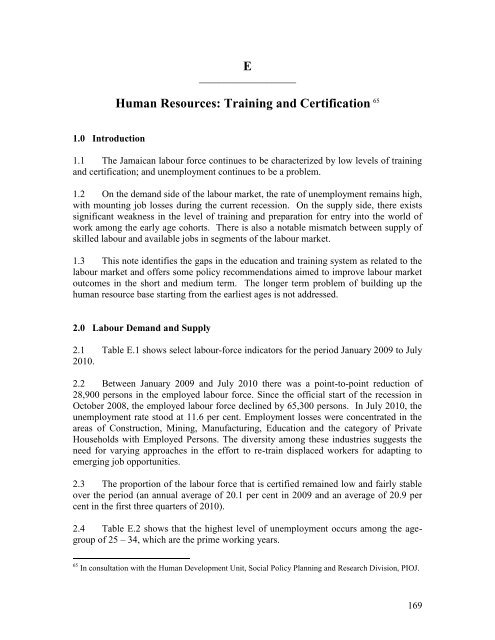PIOJ Growth-Inducement Strategy - Planning Institute of Jamaica
PIOJ Growth-Inducement Strategy - Planning Institute of Jamaica
PIOJ Growth-Inducement Strategy - Planning Institute of Jamaica
Create successful ePaper yourself
Turn your PDF publications into a flip-book with our unique Google optimized e-Paper software.
E<br />
____________________<br />
Human Resources: Training and Certification 65<br />
1.0 Introduction<br />
1.1 The <strong>Jamaica</strong>n labour force continues to be characterized by low levels <strong>of</strong> training<br />
and certification; and unemployment continues to be a problem.<br />
1.2 On the demand side <strong>of</strong> the labour market, the rate <strong>of</strong> unemployment remains high,<br />
with mounting job losses during the current recession. On the supply side, there exists<br />
significant weakness in the level <strong>of</strong> training and preparation for entry into the world <strong>of</strong><br />
work among the early age cohorts. There is also a notable mismatch between supply <strong>of</strong><br />
skilled labour and available jobs in segments <strong>of</strong> the labour market.<br />
1.3 This note identifies the gaps in the education and training system as related to the<br />
labour market and <strong>of</strong>fers some policy recommendations aimed to improve labour market<br />
outcomes in the short and medium term. The longer term problem <strong>of</strong> building up the<br />
human resource base starting from the earliest ages is not addressed.<br />
2.0 Labour Demand and Supply<br />
2.1 Table E.1 shows select labour-force indicators for the period January 2009 to July<br />
2010.<br />
2.2 Between January 2009 and July 2010 there was a point-to-point reduction <strong>of</strong><br />
28,900 persons in the employed labour force. Since the <strong>of</strong>ficial start <strong>of</strong> the recession in<br />
October 2008, the employed labour force declined by 65,300 persons. In July 2010, the<br />
unemployment rate stood at 11.6 per cent. Employment losses were concentrated in the<br />
areas <strong>of</strong> Construction, Mining, Manufacturing, Education and the category <strong>of</strong> Private<br />
Households with Employed Persons. The diversity among these industries suggests the<br />
need for varying approaches in the effort to re-train displaced workers for adapting to<br />
emerging job opportunities.<br />
2.3 The proportion <strong>of</strong> the labour force that is certified remained low and fairly stable<br />
over the period (an annual average <strong>of</strong> 20.1 per cent in 2009 and an average <strong>of</strong> 20.9 per<br />
cent in the first three quarters <strong>of</strong> 2010).<br />
2.4 Table E.2 shows that the highest level <strong>of</strong> unemployment occurs among the agegroup<br />
<strong>of</strong> 25 – 34, which are the prime working years.<br />
65 In consultation with the Human Development Unit, Social Policy <strong>Planning</strong> and Research Division, <strong>PIOJ</strong>.<br />
169
















